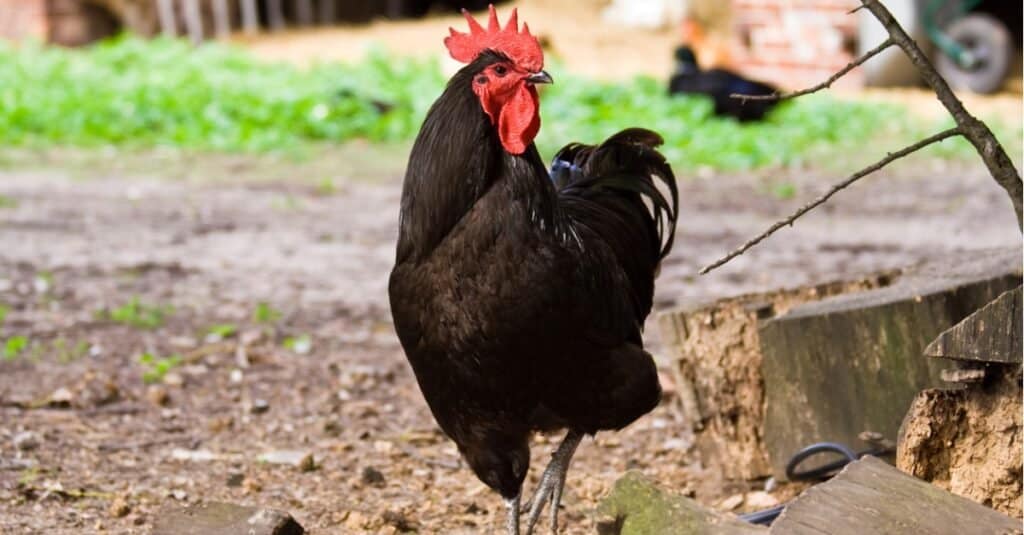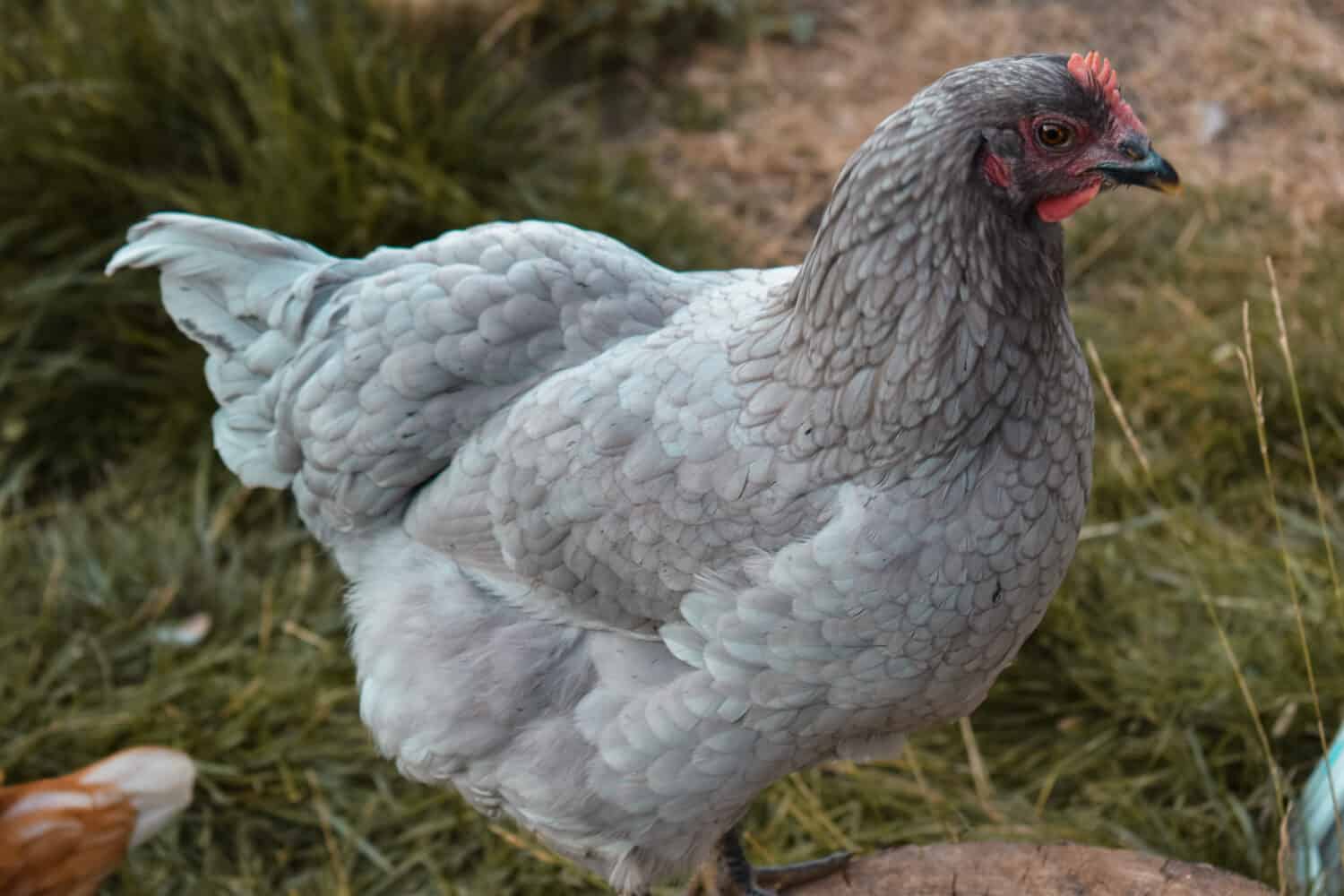Whether you are ready to start or expand your chicken flock, Jersey Giant chickens are a fantastic option. These large, friendly birds will add an interesting dynamic to your yard while also providing ample food. But why should you opt for this breed over others? That is a great question and one we explore below. We cover everything you have ever wanted to know about Jersey Giant chickens to help you make an informed purchasing decision. So, let’s dive in.
| Breed | Jersey Giant |
| Lifespan | 6 to 10 years |
| Time to Maturity | 32 to 36 weeks |
| Size | Hens weigh around 10 pounds Roosters weigh up to 13 pounds |
| Temperemant | Friendly and docile |
| Number of Eggs | 200 or more annually |
| Egg Size | Extra Large |
| Egg Color | Brown |
Where Did Jersey Giant Chickens Come From?
Two New Jersey brothers first developed this popular breed in the late 1800s (between 1870 and 1890). They intended to breed a sizable chicken that could rival turkeys. This breed experienced a period of improvement and refinement before getting accepted by the American Poultry Association (APA) in 1922. Two additional colors became recognized in later years — white in 1947 and blue in 2003.
What Is the Jersey Giant Chicken Best Known for?
Jersey Giant chickens are most well-known for their sheer size. They are the largest chicken in the U.S. That feature means they produce lots of high-quality, flavorful meat.
Jersey Giant Chicken Characteristics
Technically, Jersey Giant chickens are considered dual-purpose birds. Their sheer size means that they provide a large amount of meat. But the hens also lay a moderate number of eggs. They occasionally tend toward broody behavior, which isn’t a good thing. Since the hens are also large, they can easily crush their eggs.
This breed is cold-hardy and suitable for colder, more northerly climates. The hens tolerate cold so well they will keep laying eggs throughout the winter. However, these birds do not handle high heat well. They have far too many thick feathers to cool off properly in extreme heat.
Jersey Giants are a suitable breed to keep in a suburban or urban environment since they are relatively quiet birds. Your neighbors may never know they are there!

Jersey Giant chickens are considered dual-purpose birds. They can provide a large amount of meat, but they also lay a moderate number of eggs.
©iStock.com/Copit
What Colors Are Jersey Giant Chickens?
The APA recognizes three Jersey Giant chicken colors — white, blue, and black. White Jersey Giants are lightly colored. They have bright yellow beaks. Blue Jersey Giants are primarily blue (as their name suggests) with blue lacing. Black Jersey Giants have a greenish-black hue to their feathers but do not have feathers on their legs.
Jersey Giant Chicken Temperament
These birds are known for their friendly, docile temperament. They love their families and, despite their size, are great around kids. Since they are so easygoing, Jersey Giant chickens also get along well with most other breeds.
They also act as a sort of flock protector and will happily fight off predators. This breed also enjoys hanging out around their coop since confinement doesn’t bother them. You don’t need to worry about them flying off since their large size keeps them close to the ground.
This breed loves foraging time. They are happy roaming the yard looking for food. Their preference for free-ranging is a positive for their owners. These birds are so large they require a significant amount of feed. So, the time they spend hunting out their own food in the yard helps to naturally offset feed costs.
What Color Eggs Do Jersey Giant Chickens Lay?
This breed is known for its extra-large brown eggs. They don’t lay eggs in other colors like other breeds do.
How Many Eggs Do Jersey Giant Chickens Lay?
Jersey Giant hens are moderate egg producers. You can expect them to lay at least 200 eggs annually. However, under the right conditions and with quality feed, they could lay more. You can also potentially increase this number by collecting the eggs regularly. Doing so will prevent your hens from becoming broody (which may result in crushed eggs).
These hens take longer to reach maturity than most other breeds. So, you will have to wait a while before starting egg collection. Most will begin laying at or around the twenty-week mark. However, some may take up to a shocking seven months before reaching maturity.

Jersey Giant chickens lay extra large brown eggs.
©Sea Wave/Shutterstock.com
Do Jersey Giant Chickens Have Health Issues?
These are very healthy birds, which is a little surprising given their size. They shouldn’t need much extra care. Make sure they have plenty of air circulation in their coop to prevent overheating.
One of the main issues to watch out for is the height of their perches and nesting boxes. Since these birds are so heavy, they will get hurt if they hop down to high heights. Keep these both relatively low to prevent injury.
How Much Space Do Jersey Chickens Need?
The rule of thumb for most breeds is three to four square feet per bird. Unfortunately, that will not work for these giant birds. They need significantly more space than most other chickens. Plan on a minimum of six square feet per bird. Their run will also need to accommodate the larger birds. This breed needs at least fifteen square feet per bird.
As far as roosting space goes, they will need at least ten inches apiece. That will keep them from getting too crowded.
How Much Do Jersey Giant Chickens Cost?
Prices for these birds will depend largely on what region you live in and/or what hatchery you order them from. Every breeder will price their chicks slightly differently. Additionally, the price point varies based on whether you purchase females, males, or a straight run (not sexed). Females run between $3.55 and $4.80, males range from $2.06 to $3.21, and unsexed cost $2.59 to $4.06.
The best way to keep your per-bird cost down is to purchase more. Every hatchery offers tiered discounts based on how many chicks you buy. The more you decide to take home, the lower your per-bird price is!
Thank you for reading! Have some feedback for us? Contact the AZ Animals editorial team.








